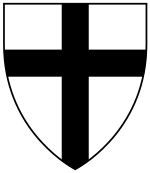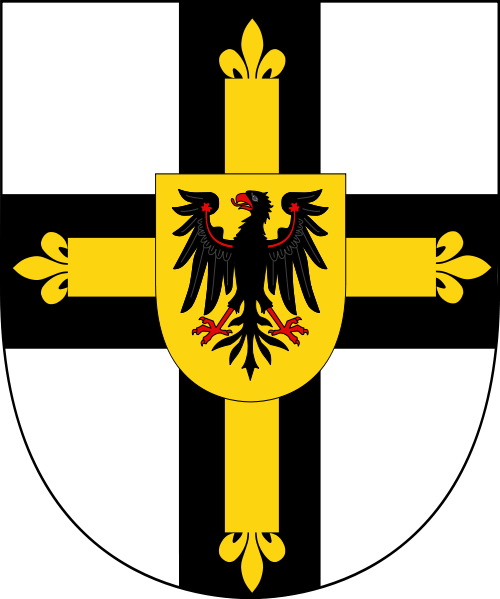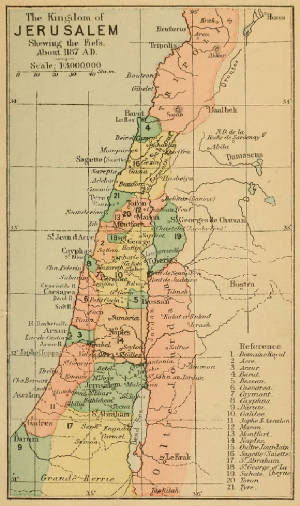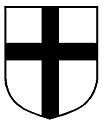 |
|
The Vassals of the Kingdom of Jerusalem The Crusader state of the Kingdom of Jerusalem, created in 1099, was divided into a number of smaller seigneuries. According to the 13th century jurist John of Ibelin, the four highest "barons" (crown vassals) in the kingdom proper were :
This fourfold division, which did not cover a number of lordships, may be an artificial creation of the 13th century, as the power of various barons fluctuated enormously during the height of the kingdom in the 12th century. There were also a number of independent seigneuries, and some land held under direct royal control, such as Jerusalem itself, Acre and Tyre. Sidon appears to have been rather small, whereas Galilee covered a disproportionate number of sub-vassals and Sidon was located between Galilee's holdings.
Northern StatesAside from the Kingdom of Jerusalem, there were also three other major Crusader states on the mainland:
These states nominally bore some dependency on the kingdom of Jerusalem. The King of Jerusalem was bound to reconcile them in case of disputes, or between a vassal Prince and the Latin Patriarich of Antioch, and could claim the regency in case of a vacancy or minority in their successions. Edessa was perhaps the most closely tied to the Kingdom, despite its distance. Its first two Counts became kings of Jerusalem, and the county was bestowed as a royal gift on Joscelin I. The County of Tripoli, the nearest of them, is sometimes considered to have been a vassal lordship under the king's suzerainty, although it preserved an extraordinary degree of sovereignty. Antioch was almost independent, for it was founded already before the kingship and its first holder was a rival of kings, the original leader of the crusade. Later in its history, it would at times recognize Byzantine or Armenian suzerainty, or none at all. These states dated their documents by the reigns of their own rulers, carried out their own foreign policy, and sent military aid to the Kingdom of their own will, rather than through feudal obligation; therefore, they are generally recognized as sovereign and are treated more fully under their own articles. Inheritance in the Kingdom of JerusalemLordships in the Kingdom of Jerusalem were usually hereditary, in principle, but in practice the circumstances were such that their holders did not form long uninterrupted lines of inheritance, which was contrary to the usual patterns of succession in Europe. Firstly, in the early years of the kingdom, lords sought out their own territories, and lordships changed hands often. Secondly, the average lifespan of male lords in Palestine was rather low, due to the constant state of warfare and violence, which led to inheritances by females and/or extinction of whole families. Succession from father to son happened more rarely than in more peaceful countries in Europe. Female succession opened up the option for the liege or the monarch to reward services, loyalty and capability, as well as achievements, by giving an heiress' hand in marriage and her inherited lordship to a "new man". A typical succession pattern was a father followed by a daughter, sister, or niece, who was then married to a man worthy of some reward, who then himself succeeded to the territory. This made the succession unpredictable and caused the family holding a particular territory to change once or perhaps even more often in a generation. Sometimes families became extinct, or escaped from Syria, and either a distant relative came to claim their land, or more usually, their liege gave the lordship to another family. Sometimes a lord was condemned for treason, rebellion or some other reason, and he and possibly his descendants were disinherited from the lordship. Occasionally, vacant lordships were put into the royal domain, but more often, another person received the lordship. A less careful observer may think that they were not hereditary, but almost always their succession took place according to feudal rights of inheritance, utilizing the relatively high number of heiresses. Many of these seigneuries ceased to exist after the loss of Jerusalem in 1187, and the rest of them after the fall of Acre in 1291, yet they often had Cypriot or European claimants for decades or centuries afterwards; these claimants, of course, held no actual territory in Syria after the mainland kingdom was lost. County of Jaffa and AscalonJaffa, on the Mediterranean coast, was fortified after the First Crusade, and was a separate county until the revolt of Hugh II of Le Puiset in 1134. Afterwards, it was usually held directly by the royal family or one of their relatives. After 1153 it was the double County of Jaffa and Ascalon, when the Egyptian fortress of Ascalon was conquered. It passed in and out of direct royal control, and became titular after the fall of Acre in 1291. A number of seigneuries were vassals to the Count of Jaffa: Lordship of RamlaOriginally held by the Bishop of Ramla-Lydda, in 1126 Ramla became part of Jaffa, and a separate lordship was created after Hugh II's revolt in 1134. The castle of Ibelin happened to be located quite near Ramla. It was later a part of the Ibelin possessions, inherited from Helvis of Ramla, daughter of Baldwin of Ramla and wife of Barisan of Ibelin. Lordship of IbelinThe Lordship of Ibelin was also created out of Jaffa (in the 1140s, or perhaps as early as 1134 after Hugh II's revolt). The lordship was given as a reward to Barisan of Ibelin, whose wife Helvis of Ramla already owned lands in the vicinity. The castle of Ramla, the family's other inheritance, was nearby, and together these territories formed a wealthy entity. Lord Balian of Ibelin married Maria Comnena, widow of King Amalric I, and the Ibelins became the most powerful noble family of the kingdom, later ruling also over Beirut. Lordship of MirabelMirabel was separated from Jaffa after the revolt in 1134, and also given to Barisan of Ibelin, although it was separate from Ibelin. Principality of GalileeThe Principality of Galilee was established by Tancred in 1099. The principality became the fief of the families of St. Omer, Montfaucon (Falcomberques), and then Bures, and its main seat was in Tiberias; thus it was sometimes also called the Principality of Tiberias or the Tiberiad. The Principality was destroyed by Saladin in 1187, although the title was used by relatives and younger sons of the kings of Cyprus (the titular kings of Jerusalem) afterwards. The Principality also had its own vassals, the Lordships of Beirut, Nazareth and Haifa, which often had their own sub-vassals. Lordship of BeirutBeirut was captured in 1110 and given to Fulk of Guînes. It was one of the longest-lived seigneuries, surviving until the final collapse of the kingdom in 1291, although only as a tiny strip on the Mediterranean coast surrounding Beirut. It was important for trade with Europe, and had its own vassals within the Principality of Galilee. The Lords of Beirut were :
The sub-vassals of Beirut were: Lordship of BaniasBanias (Caesarea Philippi) was given to Baldwin II by the Assassins in 1128. Banias was merged with Toron under Humphrey II of Toron until it fell to Nur ad-Din Zangi in 1164, and when it was recovered it became part of the Seigneury of Joscelin III of Edessa (see below). Lordship of ToronThe castle of Toron was built by Hugh of St. Omer to help capture Tyre, and was given to Humphrey I in 1107. The lords of Toron tended to be very influential in the kingdom; Humphrey II was constable of Jerusalem, as was Humphrey III. Humphrey IV was married to Isabella, Amalric I's daughter. Toron was later merged with the royal domain of Tyre. Toron had two vassals of its own, the Lordship of Castel Neuf, which fell to Nur ad-Din in 1167, and the Lordship of Toron Ahmud, which was sold to the Teutonic Knights in 1261. Lordship of NazarethNazareth was the original site of the Latin Patriarch, established by Tancred. It was created as a seigneury in Galilee in 1115. Lordship of HaifaHaifa was partly an ecclesiastical domain ruled by the Archbishop of Nazareth, and partly created from other lands in the Principality of Galilee. Lordship of SidonSidon was captured in 1110 and given to Eustace I Grenier. Lordship of CaesareaCaesarea was captured in 1101 and given to the Archbishop of Caesarea. Odo Arpin of Bourges may have been first lord, but the true first lord was probably Eustace I Grenier. Lords of Caearea were :
Lordship of the SchufThe Schuf was created out of the Lordship of Sidon as a sub-vassal around 1170. It was centred on the Cave of Tyron. Julian of Sidon sold it to the Teutonic Knights in 1256. Lordship of OultrejordainThe Lordship of Oultrejordain, consisting of land with an undefined boundary to the east of the Jordan River, was one of the largest and most important seigneuries. It was an important source of revenue, from the Muslim caravan routes that existed there. The last lord, Raynald of Châtillon, received Oultrejordain by marrying its heiress, Stephanie of Milly. Raynald considered himself Prince of Oultrejordain, not subject to the King, and was especially hostile to the Muslims. He was largely responsible as the pretence for Saladin's invasion of the kingdom in 1187. Saladin conquered much of the area in 1187 and personally executed Raynald at the Battle of Hattin. Other seigneuries(Titular lords/princes are italicized) Principality of Bethlehem
Lordship of AdelonThis lordship seems to have been created after the centre of the kingdom was moved to Acre, and held some influence under Frederick II, Holy Roman Emperor.
Lordship of ArsufArsuf, located north of Jaffa, (called Arsur by the Crusaders) was captured in 1101 but remained a royal domain until around 1163 when John of Arsuf became lord.
Lordship of BethsanBethsan was occupied by Tancred in 1099; it was never part of Galilee, despite its location, but became a royal domain in 1101, probably until around 1120. It occasionally passed back under royal control until new Lords were created.
Lordship of BlanchegardeBlanchegarde (modern Tell es-Safi) was built by King Fulk in 1142, as part of the royal domain, and administered by royal castellans. It became a lordship in 1166, when it was given to Walter I Brisebarre who had been forced to give up Beirut.
Lordship of CaymontCaymont was created after the Third Crusade for Balian of Ibelin, who had lost his other territories to Saladin. It eventually passed into the royal domain. Lordship of DeraLittle is known about Dera, except that it was created in 1118. Lordship of HebronHebron, known to the Crusaders as "Castellion Saint Abraham", was one of the earliest seigneuries created. Hebron had been under royal control at various times before 1149. It had its own sub-vassal, the Lordship of Beth Gibelin, created by Fulk in 1149. Soon afterwards Hebron became a royal domain and Beth Gibelin passed to the Hospitallers.
Lordship of MontgisardMontgisard was built as a defense against Nur ad-Din Zangi, and was the site of the Battle of Montgisard in 1177.
Lordship of NablusNablus was first captured by King Baldwin I. Named "Naples" by the crusaders,it later seems to have been created as a separate lordship out of part of Oultrejordain. It was lost during Saladin's conquest of the kingdom.
Nablus was technically part of the royal domain, and also had a royal viscount, who governed in place of the monarch :
Lordship of ScandalionScandalion, today's Iskandarouna in the Tyre District of the South Governorate of Lebanon, was built in 1116 as a royal domain.Denys Pringle quotes William of Tyre indicating the year 1117 for the date when Baldwin I has built the castle of Scandalion. It became a lordship by 1148 when Guy of Scandalion was created lord.
Lordship of TyreConrad of Montferrat practically created this lordship during the Third Crusade by defending it, as it was the only remaining town of the kingdom. Tyre, always an important town, had been part of the royal domain, and after Conrad, it also belonged to the kings personally. After the kingdom moved to Acre, coronations took place in Tyre. Sometime after 1246, Tyre was conferred upon Philip of Montfort by Henry I of Cyprus (then Regent of Jerusalem) for his support of the Ibelin (baronial) party against the Imperialists. The grant was confirmed c. 1269 by Hugh III of Cyprus, with a clause allowing Hugh to buy back the lordship. This was exercised in 1284, when the city was given to his sister Margaret, already the Dowager Lady of Tyre. Lordship of Joscelin III of EdessaThis lordship, often called the seigneurie de Joscelin, was an unusual creation given to Joscelin III, the nominal Count of Edessa, which had been lost long before. It was created around 1176 when Joscelin married Agnes of Milly, and was formed from royal land around Acre. Joscelin had only daughters, who married into the families of von Henneberg and Mandelee. The heirs sold in 1220 the seigneury to the Teutonic Knights, who used the place near Acre as their fortress in Outremer. The archives of the lordship are the only baronial archives of Outremer to survive. |






